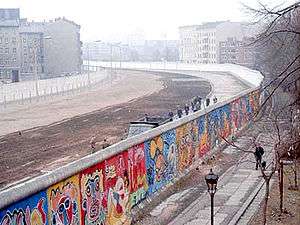Berlin Wall graffiti art

The Berlin Wall was constructed in 1961 to separate West Berlin and East Berlin during the Cold War. All the differences between the countries made it a perfect place for people to express their opinions, especially on their preferences and dislikes. In the 1980s, the wall was reconstructed and made 14 feet tall. Graffiting on the wall became popular for artists from all over the world and a place where tourists would go and admire the artwork. The West Berlin side of the wall had artwork completely covering the wall, while the East Berlin side was kept blank because people were not permitted to get close enough to the eastside of the wall to paint anything.
The Berlin Wall was the largest canvas in the world. Much of the artwork was not claimed by artists and remains anonymous. Because the wall was open to everyone, there were no restrictions on what artists could put on the wall. Over the past 30 years since the collection of artwork was started, much of the controversial artwork has been removed from the wall. Almost all of the wall has been removed and it only exists in places such as Potsdamer Platz, the East Side Gallery, and Bernauer Straße; many segments are now exhibited in other countries; see List of Berlin Wall segments.
Gallery
-

My God, Help Me to Survive This Deadly Love, Leonid Brezhnev and Erich Honecker in a fraternal embrace, reproducing a photograph that captured the moment in 1979 during the 30th anniversary celebration of the foundation of the German Democratic Republic
-
Original part of the Berlin Wall 1989; gift from Daimler-Benz AG to Bill Gates on February 8, 1996. At Microsoft Conference Center in Redmond, WA
-

Near Potsdamer Platz, 1986
-

Variations on the Statue of Liberty, 1986
See also
References
- ↑ Arms, Simon. "The Heritage Of Berlin Street Art And Graffiti Scene.". Smashing Media. Retrieved 23 January 2013.
External links
- http://www.berlinwallart.com/
- http://www.dailysoft.com/berlinwall/art/index.htm
- http://www.berlinwallart.com/literature.htm
- http://www.smashingmagazine.com/2011/07/13/the-heritage-of-berlin-street-art-and-graffiti-scene/